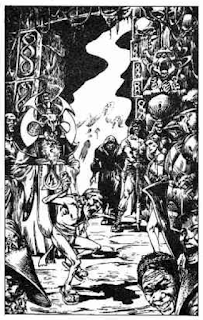 The plot of Deathtrap Dungeon was inspired by a holiday Ian Livingstone had taken to Thailand. “I went trekking in Northern Thailand in 1981,” explains
Livingstone. “I passed through Fang and crossed the River Kok on my way to the
jungle near the Burmese border. I took lots of photos of villagers and scenery
on the trek. It was an incredible adventure, and one not without drama. Our
guide was constantly fretting about armed bandits coming over the border to rob
us! The trek made a big impression on me, enough for me to want to reference
the people and places in Deathtrap
Dungeon which I began writing in late 1983. But the dungeon plot itself was
a product of the dungeons I’d designed during the years I’d been playing D&D. When Penguin Books told us they
wanted a sequel to The Warlock of Firetop
Mountain, I thought I’d write a classic dungeon-bash next, but I put it on
hold and wrote The Forest of Doom and
City of Thieves before Deathtrap Dungeon.”
The plot of Deathtrap Dungeon was inspired by a holiday Ian Livingstone had taken to Thailand. “I went trekking in Northern Thailand in 1981,” explains
Livingstone. “I passed through Fang and crossed the River Kok on my way to the
jungle near the Burmese border. I took lots of photos of villagers and scenery
on the trek. It was an incredible adventure, and one not without drama. Our
guide was constantly fretting about armed bandits coming over the border to rob
us! The trek made a big impression on me, enough for me to want to reference
the people and places in Deathtrap
Dungeon which I began writing in late 1983. But the dungeon plot itself was
a product of the dungeons I’d designed during the years I’d been playing D&D. When Penguin Books told us they
wanted a sequel to The Warlock of Firetop
Mountain, I thought I’d write a classic dungeon-bash next, but I put it on
hold and wrote The Forest of Doom and
City of Thieves before Deathtrap Dungeon.”
As well as the River Kok and Fang, the names of several
other places Livingstone visited on that fortuitous trip made it into the book,
including Chiang Mai. Baron Sukumvit himself was named after Sukumvit
Road in Bangkok. The marriage of both eastern and western influences
in the adventure created something entirely new, helping to give the world of
Fighting Fantasy a truly unique flavour.
 Deathtrap
Dungeon was a huge success, selling over 350,000 copies in its first year
alone. It was the best-selling children’s book in April 1984 and was ranked 8th
out of all books sold that month, coming just behind Dick Francis in 7th
place and ahead of Stephen King’s Christine
in 9th. (Three of the top one hundred books sold that year were
Fighting Fantasy gamebooks.) Deathtrap
Dungeon was so successful that Livingstone’s eighth gamebook was a sequel, Trial of Champions (FF21, published in
1986). It even spawned a video game.
Deathtrap
Dungeon was a huge success, selling over 350,000 copies in its first year
alone. It was the best-selling children’s book in April 1984 and was ranked 8th
out of all books sold that month, coming just behind Dick Francis in 7th
place and ahead of Stephen King’s Christine
in 9th. (Three of the top one hundred books sold that year were
Fighting Fantasy gamebooks.) Deathtrap
Dungeon was so successful that Livingstone’s eighth gamebook was a sequel, Trial of Champions (FF21, published in
1986). It even spawned a video game. Deathtrap
Dungeon
has a fantastic, totally immersive setting and it's really tricksy; I
probably had up to six fingers nestled in the pages as bookmarks at one point,”
says author and FF fan Magda Knight. “Some may argue that the original books
were less richly plotted than their successors, but I loved the setup of the
Trial of Champions, the original Hunger
Games. It appealed to my competitive nature. The illustrations flash up in
my memory to this day, and the concept of an underground maze full of traps
worked so well with the nature of the books. I also loved how Fang was placed
so near to Port Blacksand, which meant that I was beginning to build up a
picture of a world through these adventures.”
Deathtrap
Dungeon
has a fantastic, totally immersive setting and it's really tricksy; I
probably had up to six fingers nestled in the pages as bookmarks at one point,”
says author and FF fan Magda Knight. “Some may argue that the original books
were less richly plotted than their successors, but I loved the setup of the
Trial of Champions, the original Hunger
Games. It appealed to my competitive nature. The illustrations flash up in
my memory to this day, and the concept of an underground maze full of traps
worked so well with the nature of the books. I also loved how Fang was placed
so near to Port Blacksand, which meant that I was beginning to build up a
picture of a world through these adventures.” Like City of Thieves before it, Deathtrap Dungeon was illustrated inside
and out by Ian Livingstone’s favourite FF artist, Iain McCaig.
Like City of Thieves before it, Deathtrap Dungeon was illustrated inside
and out by Ian Livingstone’s favourite FF artist, Iain McCaig.
“My favourite black and white illustration is the image of
the inscrutable Trialmaster on his dragon-hide throne from Deathtrap Dungeon,” muses McCaig. “It was the height of my love
affair with croquill pens, and the quintessential riddle picture that would
lead to Casket of Souls.”
For more stories about the creation of your favourite Fighting Fantasy gamebooks, pick up a copy of YOU ARE THE HERO - A History of Fighting Fantasy Gamebooks.

No comments:
Post a Comment